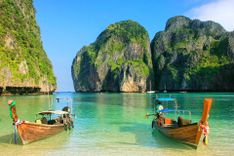Phi Phi activities
Snorkelling
There’s some great snorkelling around Phi Phi’s shallow fringing reefs, most rewardingly at strikingly beautiful Ko Mai Pai (Bamboo Island), off Phi Phi Don’s northeast coast, where much of the reef lies close to the surface, and at nearby Ko Yung (Mosquito Island), with its spectacular, steep-sided drop. Phi Phi Don has its own worthwhile reefs too, including at west-coast Ao Yongkasem, within kayaking distance of Loh Dalum, but Ao Maya on Phi Phi Leh is more famous, and a lot more crowded.
Outings are easily arranged as part of an organized tour (B500–800 including equipment) or by hiring your own longtail boatman (B1500/3000 per boat per half/full day), the latter far preferable to the largest tour boats, whose groups of forty-plus trippers inundate the reefs. Overnight camping trips to Maya Bay are a neat way of avoiding the crowds, offering late-afternoon snorkelling, and possibly kayaking, rounded off with a beach barbecue.
Diving
Offering visibility touching 30m, a great diversity of healthy hard and soft corals, and potential encounters with white-tip sharks, moray eels and stingrays, the diving around Ko Phi Phi is the best in the area and the usual destination of dive boats from Ao Nang and Phuket. Highlights include the gorgonian sea fans, barracudas, manta rays and even whale sharks at Ko Bidah Nok and Ko Bidah Nai, the mass of leopard sharks at Hin Bidah, and the King Cruiser wreck.
There are at least twenty dive shops on Phi Phi, the majority of them in Ton Sai; seven of them have formed the Phi Phi Diving Association to promote eco-friendly, responsible and safe diving practices. Note that it’s considered risky for a novice diver with fewer than twenty dives to dive at Hin Daeng and Hin Muang, due to the depth and the current; reputable dive shops will only take Advanced Divers there. There are also small dive centres on Hat Yao, Ao Loh Bakao and Laem Tong.
Prices for day-trips including two tanks, equipment and lunch start at B2500, while the four-day PADI Openwater course costs B13,800. Check that your dive operator is insured to use one of the recompression chambers on Phuket.
Rock-climbing
The main rock-climbing area is just to the west of Ao Ton Sai, and includes the Ton Sai Tower and the Drinking Wall, with thirty routes from grades 5 to 7a. A newer attraction is deep-water soloing, unaided climbing on cliffs and outcrops over the sea.
Bird’s-nesting
Prized for its aphrodisiac and energizing qualities, bird’s-nest soup is such a delicacy in Taiwan, Singapore and Hong Kong that ludicrous sums of money change hands for a dish whose basic ingredients are tiny twigs glued together with bird’s spit. Collecting these nests is a lucrative but life-endangering business: sea swifts (known as edible-nest swiftlets) build their nests in rock crevices hundreds of metres above sea level, often on sheer cliff-faces or in cavernous hollowed-out karst. Nest-building begins in January and the harvesting season usually lasts from February to May, during which time the female swiftlet builds three nests on the same spot, none of them more than 12cm across, by secreting an unbroken thread of saliva, which she winds round as if making a coil pot. Gatherers will only steal the first two nests made by each bird, prising them off the cave walls with special metal forks. This in theory allows the bird to build a final nest and raise her chicks in peace. Gathering the nests demands faultless agility and balance, skills that seem to come naturally to the chao ley, whose six-man teams bring about four hundred nests down the perilous bamboo scaffolds each day, weighing about 4kg in total. At a market rate of up to $2000 per kilo, so much money is at stake that a government franchise must be granted before any collecting commences, and armed guards often protect the sites at night. The chao ley seek spiritual protection from the dangers of the job by making offerings to the spirits of the cliff or cave at the beginning of the season; in the Viking Cave, they place buffalo flesh, horns and tails at the foot of one of the stalagmites.
In recent years, entrepreneurs in Ban Laem, near Phetchaburi, across on south Thailand’s Gulf coast, have started competing with the chao lay – by constructing sea swift condominiums and trying to attract the swiftlets that frequent the attic of the nearby temple. The theory is that by constructing windowless concrete towers that mimic the Andaman Sea caves – complete with cool dark interiors and droppings-smeared walls, plus swiftlet soundtracks on continuous replay – they can entice the birds in to build their nests and harvest them with ease. To date, the main beneficiary seems to have been the construction company that builds these ugly towers, as the local swiftlet population suddenly has an awful lot of new accommodation to choose from.
Thinking of travelling to Thailand? Start planning by learning about how to get there.





